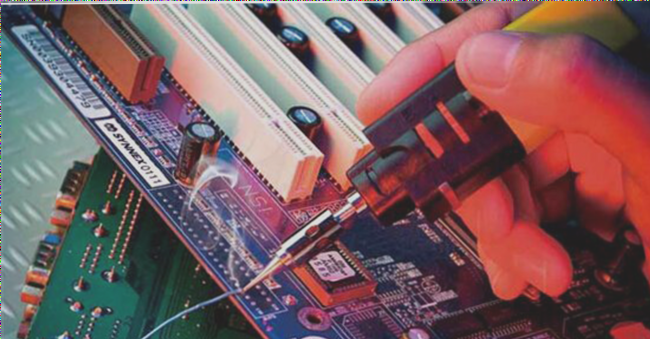This article introduces the types of industrial PCB circuit boards based on layers: single-layer, double-layer, and multi-layer.
Layer-based industrial PCB types:
PCB manufacturing is often more challenging than designing a PCB. Over time, designers have sought ways to integrate multiple circuits onto the same platform.
With technological advancements, PCB manufacturers are encountering increasing challenges.
Depending on circuit complexity, PCBs can range from a single layer to 8 layers.
In extremely complex circuits, the number of layers may exceed 8. Different PCBs are used based on specific requirements.
Single-layer PCB:
This type is based on a single-layer substrate with copper foil attached to it.

1. The solder mask acts as a protective layer, while names and values of different components are indicated using the silk screen.
2. One of the biggest advantages of a single-sided PCB is its low manufacturing cost.
3. The single-layer PCB structure is simple and suited for low-configuration systems, such as relay modules, infrared sensor modules, and single LED modules.
4. Due to its unsuitability for high-configuration systems, it is rarely used in industrial applications.
5. Double-layer PCB:
6. This type of board includes a substrate layer with conductive layers on each side.
7. The conductive layers are connected through plated holes.
8. Typically, surface mount technology is employed to place components on both sides of the board.
9. This method allows components to adhere directly to the surface.
10. The double-layer PCB structure is more complex than that of a single-layer PCB and can handle more intricate tasks.
11. It is commonly used in power monitoring systems, test equipment, and amplifiers, increasing operational flexibility and allowing denser circuit designs.
12. Due to its durability, reliability, and capability to manage complex tasks, it is prevalent in many industrial applications.
13. Multilayer board:
14. Multilayer PCBs consist of more than two conductive layers.
15. A core substrate supports the first two layers, which are attached using adhesive or high temperature and pressure, similar to a double-layer PCB.
16. Additional layers are connected to the core and insulated with thin insulating material.
17. Multilayer PCBs enable more complex circuit and wiring combinations, with layers ranging from 3 to 8, and sometimes exceeding 8 layers.
18. Due to their higher assembly density, multilayer PCBs are often preferred for compact designs compared to single- and double-layer types.
19. Most manufacturers use this PCB format for highly complex designs, making it common across various industrial applications.
20. A major advantage of multilayer PCBs is their ability to handle very complex tasks and support high-configuration systems efficiently.
Layer-based industrial PCB types:
PCB manufacturing is often more challenging than designing a PCB. Over time, designers have sought ways to integrate multiple circuits onto the same platform.
With technological advancements, PCB manufacturers are encountering increasing challenges.
Depending on circuit complexity, PCBs can range from a single layer to 8 layers.
In extremely complex circuits, the number of layers may exceed 8. Different PCBs are used based on specific requirements.
Single-layer PCB:
This type is based on a single-layer substrate with copper foil attached to it.

1. The solder mask acts as a protective layer, while names and values of different components are indicated using the silk screen.
2. One of the biggest advantages of a single-sided PCB is its low manufacturing cost.
3. The single-layer PCB structure is simple and suited for low-configuration systems, such as relay modules, infrared sensor modules, and single LED modules.
4. Due to its unsuitability for high-configuration systems, it is rarely used in industrial applications.
5. Double-layer PCB:
6. This type of board includes a substrate layer with conductive layers on each side.
7. The conductive layers are connected through plated holes.
8. Typically, surface mount technology is employed to place components on both sides of the board.
9. This method allows components to adhere directly to the surface.
10. The double-layer PCB structure is more complex than that of a single-layer PCB and can handle more intricate tasks.
11. It is commonly used in power monitoring systems, test equipment, and amplifiers, increasing operational flexibility and allowing denser circuit designs.
12. Due to its durability, reliability, and capability to manage complex tasks, it is prevalent in many industrial applications.
13. Multilayer board:
14. Multilayer PCBs consist of more than two conductive layers.
15. A core substrate supports the first two layers, which are attached using adhesive or high temperature and pressure, similar to a double-layer PCB.
16. Additional layers are connected to the core and insulated with thin insulating material.
17. Multilayer PCBs enable more complex circuit and wiring combinations, with layers ranging from 3 to 8, and sometimes exceeding 8 layers.
18. Due to their higher assembly density, multilayer PCBs are often preferred for compact designs compared to single- and double-layer types.
19. Most manufacturers use this PCB format for highly complex designs, making it common across various industrial applications.
20. A major advantage of multilayer PCBs is their ability to handle very complex tasks and support high-configuration systems efficiently.

